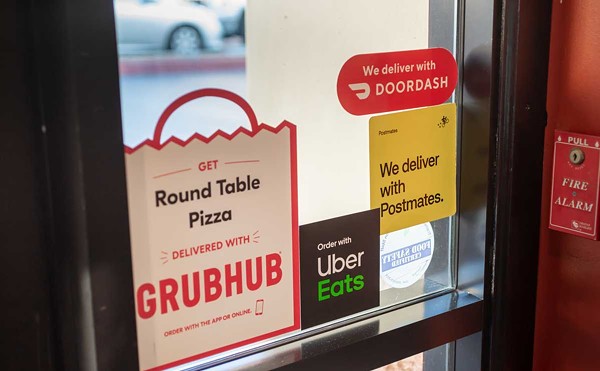Finding a welcome gift for a bona fide chow freak can be a little frustrating if they’re actively pursuing their mania. Here are some dead-bang ideas, every one of them — as Grandpa used to say — a dandy:
A fungus rarely among us — There’s only one thing bad about the truffle — not the often over-rich confection that leaves unsweetened cocoa powder on chins, dress fronts and furniture, but the aromatic, rare and highly prized fungus that grows underground, attached to hardwood tree roots:
It costs too damn much for most of us ever to have a chance to taste more than a sliver.
The truffle is downright ugly to behold — bumpy, misshapen, ranging in color from black to off-white — and looks like something you’d see floating in a mason jar full of formaldehyde at a sideshow exhibit of anatomical curiosities. But the pungent smell and the taste are unlike anything else (otherwise I’d try to give you a comparison).
Truffles’ always high prices can spike wildly, and recently reached as much as $4,200 a pound. But there’s now an intriguing possibility not only of getting a good taste of truffles, but maybe as much as you can handle, and the added potential of selling what you can’t use.
While commercial truffle-growing operations have been around Europe for a long time, a new outfit called Truffle Tree is trying something I haven’t found elsewhere. For an initial fee of $239, and $55 a year for care and maintenance, anyone can adopt a truffle oak in the south of France.
Dick Pyle, a former high-end restaurateur in London, has put science, agriculture and backbone to work establishing himself as a truffiere.
I can’t vouch for his success or your potential for sharing it, but photos of the operation and information about taking part are at Pyle’s Web site, truffle-tree.co.uk. If your tree bears fungus, you can have the precious truffles shipped to you as they’re harvested (specially trained pigs and dogs sniff them out, and the truffle hunter tries to beat them to the booty, before they eat it); put them in a pool to be marketed, or do some of both.
It’s certainly a risky investment, but I suppose no more so than more conventional trading in stocks. If you’re interested, drop me a line. Truffle Tree has shown some interest in discounts for our readers.
How you slice it — Why, given all the foregoing, would I recommend a kitchen gadget that is specifically designed to slice truffles? Simply because, with a little imagination, you can find all kinds of other uses for it in the kitchen.
I’ve never once used mine to fine-slice a nice big fungus. But I have used the razor-edged thing to shave walnuts and pecans over cakes and tarts; to sliver hard cheese on pasta, pizza and bruschetta; to make paper-thin wafers of fresh garlic for those who like it raw in salsa or bread dips; and to cleanly sever transparently thin slices of my own fingertips and palm because I wasn’t paying attention.
Those who believe high price equals high quality can find them online and at tony kitchenware shops for $30, $40 and more. Mine is just as sharp, just as sturdy as any of them. I picked it up for 10 bucks on Amazon.
It’s not the meat, it’s the emotion — Bill Niman’s ranch in Bolinas, Calif., is now widely regarded as a model of sustainable farming. What began almost accidentally as a small family operation, meant to put food only on its own table, has become the darling of restaurateurs and soft-hearted meat lovers across the country for the care and humanity that Niman Ranch puts into bringing livestock to market. If you’ve tasted Niman meat in any of our better local eateries or bought some at such high-end markets as Papa Joe’s, the quality speaks for itself.
The full story has been collected, along with dozens of well-written recipes, in The Niman Ranch Cookbook (Ten Speed, $35), by Bill Niman and Janet Fletcher. If PETA is bumming you out, or vegetarians of your acquaintance have managed to plant some guilt in your carnivore’s soul, assuage it with this fine book.
King of the cloven hoof — Speaking of Papa Joe’s, it’s been quietly peddling some primo pig for several months now, and a hunk of it would make a mighty nice gift for the pork-lover in your life.
I got hold of some chunks of Berkshire hog because it promised to be the best pigmeat I’d had in a long life of enjoying the noble hog, both in temperament and taste, from my uncle’s backyard pigpens in Terre Haute, Ind., to curbside barbecue pits throughout Detroit to backwoods joints in the South; from snout to tail. But the Berkshire hog, prized for centuries in Europe, was nearly impossible to find in this country until fairly recently.
Berkshire pork is darker than “the other white meat” we’re used to, beautifully marbled, free of hormones and antibiotics, and comes from Iowa farmers who husband their animals with the same philosophy and care as Bill Niman.
And what I was promised is true: It’s the most full-flavored, tender and juicy pig-eating experience I’ve had.
Because it sells for about half-again as much as run-of-the-mill agribusiness pork, Time magazine called it “the Ben & Jerry’s” of pig meat. And like that stuff, it’s worth the money, if only on special occasions.
Ric Bohy is editor of Metro Times. Send comments to [email protected]




